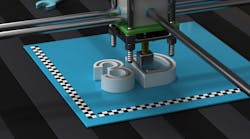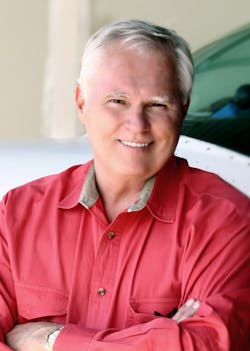When you think of 3D printing, images of space-age shapes probably get conjured up, and maybe even a guy named Chuck Hull. Hull—now 75, and still working as chief technology officer of 3D Systems—is the man widely dubbed as the "Father of 3D printing.” And it’s true that Hull patented a 3D invention back in 1986.
But few people know that two years earlier, in the heat and humidity of Greenville, S.C., the idea had already been brought to life by entrepreneur Bill Masters.
Masters grew up in Easley, S.C., and threw himself into science and engineering as a kid. This passion followed him to college, where he studied electrical engineering while working a 40-hour week on the side. Today, he still resides (and invents!) in South Carolina, but is better known as the father of modern kayaking—founding and running Perception Kayaks from 1975 to 1998—than he is for his printing inventions.
It was actually during a kayaking trip, on the banks of the Chattooga River under the 76 bridge (on the South Carolina side, to be exact) when Masters began thinking about spitballs…which would eventually led him to 3D printing.
“I was sleeping on the side of the river on my kayak, looking up at the stars,” he remembers, “and I realized if you could take one star and make that your seed point, you could add stars from any direction until you had the shape you wanted.
“Similarly, if you shoot a spit ball down and it sticks, you can then shoot multiple down on top of it,” he continues. “They stick and stick and stick until eventually you can build something with them.”
This was in the 1970s, and it took Masters a few years to develop the idea and save enough to afford the patent. But by 1984, his “Computer Automated Manufacturing Process and System” was ready. He filed U.S. Patent 4,665,492 A on July 2nd—two full years before Hull patented his “Apparatus for Production of Three-Dimensional Objects by Stereolithography” In fact, it was the first of five patents belonging to Masters that laid the foundation for the 3D printing systems used today. In fact, he says his patents still have parts that no one has replicated to this day.
“I didn’t know at the time I was the first,” Masters recalls. “And to be honest, after Hull came out with his I just assumed I wasn’t. It wasn’t until years later I looked at the patent dates and realized, ‘Wow, I was filed before everyone.’”
But, what could have been a multimillion-dollar idea in what has become a $6 billion industry never came to be, and Masters never became a recognized name associated with 3D printing. Instead, he founded Perception Systems, which received seed funding from a South Carolina venture capital group, Palmetto Seed Capital.
In a classic case of venture capitalist follow on funding, Masters lost control of his patents. The company was renamed BPM technology and burned through millions chasing complex software to control a simple process similar to what is the standard today. Eventually, BPM went out of business and Master’s patents were lost.
In the meantime, other entrepreneurs had become connected with the industry. The aforementioned Chuck Hull, who was given his “Father of 3D Printing” title by The Guardian, has also been inducted into the National Inventors Hall of Fame. There is also the husband-and-wife team of S. Scott and Lisa Crump who co-founded Stratasys, and who have been inducted into the Minnesota Inventors Hall of Fame.
Although he faded out of the 3D printing industry, Master’s kayak company—Perception—blossomed. He sold the company in 1998 and has been inducted in the International Whitewater Hall of Fame because of his efforts. Now in his 60s, he is still an active inventor and entrepreneur with more than 30 patents to his name. He is working on such innovations as drip-free honey pumps, gun safety technologies, car safes, and medical products, to name but a few. He continues to work on his 3D printing technology while admiring the impact it’s had.
“I knew in my head and heart that 3D technology could transform the way we make things when I came up with it,” Masters admits. “At that time, people in South Carolina looked at me as crazy because we had so little technology in the state. Now, South Carolina has transformed itself and crazy ideas are welcome here.
“I am proud to have been a part of my state's growth,” he adds. “Because of my state’s visionary leaders and entrepreneurial culture, I was able to leap from growing up in poverty to success.”
Masters is also using his past business experiences to fuel his passion for protecting today’s inventors/entrepreneurs who may find themselves in similar situations. Aside from advising an Entrepreneur MBA course at his Alma Mater, Clemson University, he also has some advice on what is necessary for entrepreneurial survival.
“First and foremost, the question you need to ask yourself is what type of entrepreneur are you?” he says. “We’re all born to survive, and therefore we all have some degree of entrepreneurial spirit in us. It’s where and how we adapt to the environment that determines our growth.
“Understand that there will be hurdles both in society and business you will have to cross, and we’re not all born leaders,” he concludes. “Find and trust in a good advisor who will be able to support your entrepreneurial journey, and lean on the eco-culture of entrepreneurs out there.”
More of Masters’ Tips for Entrepreneurs
- Find a good lawyer to represent you. In my experience, venture capitalists see inventors as easy prey.
- Always have a way to get your patents back if your partners don’t do as they say. One option is a fully paid license.
- Learn and understand all the terms an investor uses, especially dilution and control.
- Never sign a loan personally with an investor. You will always be the first to be sacrificed.
- Entrepreneurs are not all the same. There are inventor entrepreneurs, financial entrepreneurs, sales and marketing entrepreneurs…the list goes on. Inventor entrepreneurs tend to be visionaries, and in my experience easy to sell possibilities to. If it’s not covered in a contract, it’s not worth a lot.
- Integrity trumps contracts. Do serious, first-hand background research on any partners of any kind.
Masters’ full list of patents related to 3D printing are: 4,665,492, 5,134,569, 5,216,616, 5,546,313, and 5,694,324.




